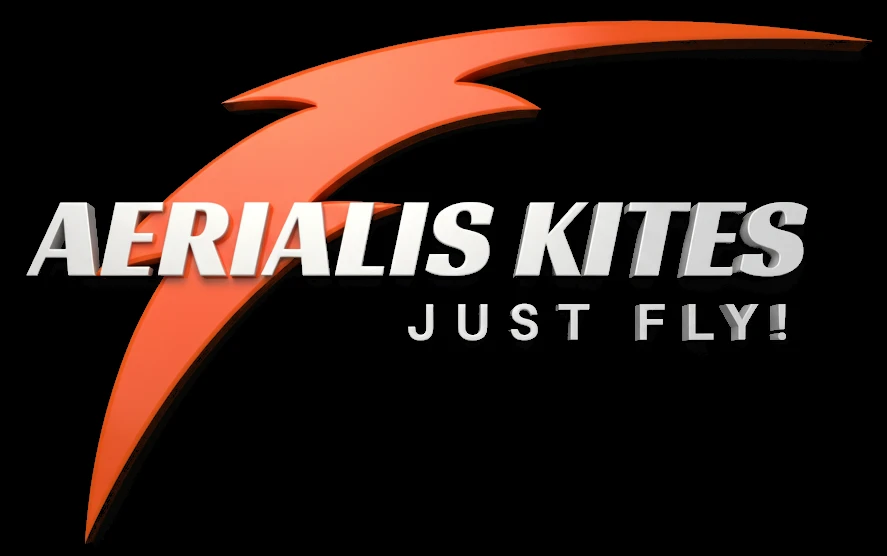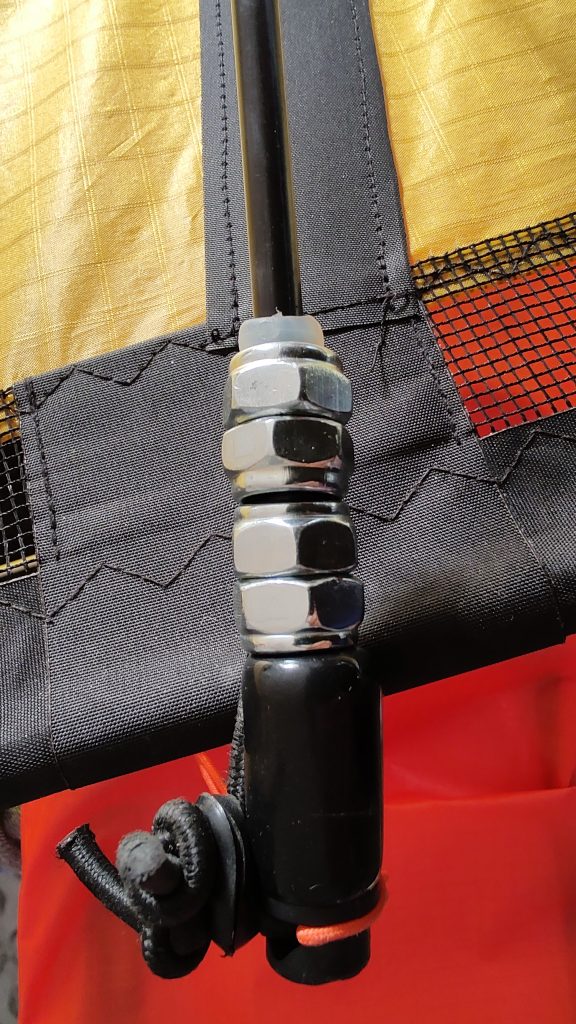But that’s where it all ended when I decided to call it a day. However, before I – literally – hung up my kite, I did have a LOT of fun with it after the latest modifications, which you can read all about in this post.
I found myself at the beach at about 19:15 in the evening and the winds were in the higher end of the kite’s wind range. No worries though, because the winds in my neck of the woods usually die down in the evening so I was hoping to have a go with the kite in a pretty wide wind range. And yes, so I did!
I started out without the weights just to get a feel for the kite and its 3D shaped sail. The new glass fibre rods seemed to keep up well shaping the sail. They bent out of position a handful of times in some gusts, however, it was just to shake the lines quickly and the GF rod popped back into position. Nice!
One cool thing I noticed this time was that you can launch the kite just by pulling on the front lines. Just grab them with one hand, give them a proper pull and the kite takes off. No, you don’t pull the kite out of the air, you will launch it and fly it! This can be (very) useful when launching in the kite’s very lower wind range. I did it a couple of times when a normal launch was difficult, but by pulling the front lines like described, the kite took off perfectly!
Then I started to add weight to the kite by adding steel nuts to the down spars.
This is a super-easy way to add weight to the upper part of the kite and hopefully, this will make the leading edge sitting a little lower in a backflipped position. Adjusting the weight is also easy as pie. Just add more steel nuts to increase the weight or remove them to reduce the weight. These adjustments literally take just a few seconds and that’s really convenient when testing!
If you take a closer look at the photo you can see the (cut off) connector keeping the nuts in place. Depending on the number of nuts, you can slide this connector up and down so it will keep the nuts – regardless of how many – in place.
I was kind of suspicious if the connector would stay in place when banging the kite around, but it surely took a beating and didn’t slide more than a couple of millimetres after some serious … well … let’s call them “landings”. 😉
Yes, adding weight surely changes the kite’s centre of gravity and the LE is sitting lower in that backflipped position! I ended up with a total of seven nuts on each down spar and even though the wind died down to almost nothing, I could still keep the kite in the air despite its increased weight.
Are the backflips more stable?
Well, yes I think the stability has increased somewhat adding this weight. But there is still a lot of work to do for the pilot to guide the kite in the air to maintain the position. Walking forwards (downwind) seems to be unavoidable and so are careful tending using the lines. However, I sure managed to keep the backflipped position for longer periods than flying without the weights and the more I practised I also managed to keep the position a little longer.
I guess with the right wind conditions and correct piloting you should be able to hold the backflip for a significant period of time.
…and having a twist in your flying lines seems to help. I think this will bring your lines closer together so the flying lines will rest on the trailing edge a little closer to the center of the kite aiding stability.
Another way cool trick(?) is the Belly Pop Up Launch! Due to the kite’s 3D shape, Belly Pop Up Launches are easy as pie! Just put the kite on the ground on its belly and the LE pointing upwind, a sharp tug on the lines will pop the kite off of the ground landing on its down spar wingtips, flying or you can even pop it directly over into a backflip and fly away! Now that is cool!!!
I could do this nine out of ten times, so yes, they’re consistent!
With its weighted LE, I could even do complete roll-ups. However, the walk of shame was required to unwrap them … so… 😉
I didn’t find any problems with self-recovery even after (heavily) weighting the kite. I could go on yanking the lines like a madman, but mostly the kite would quickly return to a flat belly down position and just slowly float downwind until the lines got tight and you could fly it again. Downwind glides are also super efficient and you can easily gain 20-25 meters flying on a 10m (30ft) set of lines!
As you probably have guessed by now, the 3rd test flight was a success! And of course, I have a video to prove it!






4 responses
> Another way cool trick(?) is the Belly Pop Up Launch! Due to the kite’s 3D shape, Belly Pop Up Launches are easy as pie! Just put the kite on the ground on its belly and the LE pointing upwind, a sharp tug on the lines will pop the kite off of the ground
Interesting, the belly pop up launch the the Fulcrum wants to do (or that I have tried?) is with the LE from the pilot, just as a dual line pop up launch would be. Otherwise I don’t flip the Fulcrum so much. Perhaps it would be easier if I switched to longer handles? I’m now using the usual 13 inch (Rev) handles or 33 cm measured along the centre line of the steel tube (will try the 39 cm (15 inch) handles that I have gotten hold of soon). What handle length do you use for the tests of the 3D quad?
> As you probably have guessed by now, the 3rd test flight was a success!
Feeling so after just a few sessions it is remarkably good. Getting to learn a radically different kite can take many sessions. Where will this end?
You now have something certainly different from a Rev-like quad with new possibilities, but how much of the original properties survived? How is the feeling? Is there also something that became harder to do?
> Downwind glides are also super efficient and you can easily gain 20-25 meters flying on a 10m (30ft) set of lines!
And you are running when gaining ground by gliding down in the video, which is efficient in itself.
Btw, could moving the bridle to the backside be a part of the testing agenda?
I know nothing about flying the Fulcrum so I can’t comment much on that kite. My handles…. mmmm… I think I used the 13″ ones. (Have to check to be certain.)
Anyway, the Belly Popup Launch is *really* easy. A sharp tug on the lines and the kite pops off of the ground. A harder tug can pop the kite directly into a backflip.
Maintaining all, or at least most, QLK characteristics is really important for me in this project and so far most of them are there. Three features missing, or at least I haven’t found out how to do them is axels, pulling the kite out of the sky (as for s catch) and throwing the kite away from you. It might be possible to do but will take other techniques than the ones I’m used to. More practice I guess. ?
Yes, I will probably do some bridle tweaks too, moving the towpoints slightly in is one of them. …and maybe try a couple of completely different bridles too.
So stay tuned! ?
> I know nothing about flying the Fulcrum so I can’t comment much on that kite. My handles…. mmmm… I think I used the 13″ ones. (Have to check to be certain.)
OK, the reason I was “nagging” 🙂 about the Fulcrum is that there is a certain feeling of the Fulcrum that is repeated in the ORAO 4 line 500, that got similar “negatively curved” bowl like parts of the wing. Not having tested the modified Lanyork of yours I kind of assume (wildly guessing) that all kites with negative curvature of the chord line behaves somewhat similar. To find the answer about the optimal handle length I asked this question on KL:
https://kitelife.com/forum/topic/10885-first-flight-of-the-fulcrum/?do=findComment&comment=84280&_rid=10687
It seems like a 14” (36cm) rather straight handle with quite short top leaders is a good one for flipping the kite (the Fulcrum) in the pitch-wise direction. The common rev handles to my understanding are (still?) a quite curved pair of 13” (33cm) handles.
> I know nothing about flying the Fulcrum so I can’t comment much on that kite. My handles…. mmmm… I think I used the 13″ ones. (Have to check to be certain.)
OK, the reason I was “nagging” 🙂 about the Fulcrum is that there is a certain feeling of the Fulcrum that is repeated in the ORAO 4 line 500, that got similar “negatively curved” bowl-like parts of the wing. Not having tested the modified Lanyork of yours I kind of assume (wildly guessing) that all kites with negative curvature of the chord line behaves somewhat similar. To find the answer about the optimal handle length I asked this question on KL:
https://kitelife.com/forum/topic/10885-first-flight-of-the-fulcrum/?do=findComment&comment=84280&_rid=10687
It seems like a 14” (36cm) rather straight handle with quite short top leaders is a good one for flipping the kite (the Fulcrum) in the pitch-wise (tipping/flipping) direction. The common rev handles to my understanding are (still?) a quite curved pair of 13” (33cm) handles.